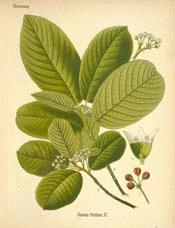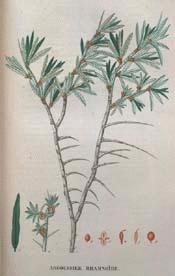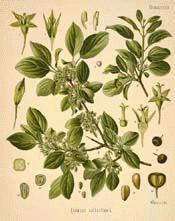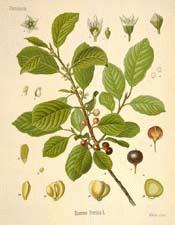
Botanical.com Home Page
BuckthornsFamily: N.O. Rhamnaceae
BUCKTHORN (COMMON)Family: N.O. Rhamnaceae---Synonyms---Highwaythorn. Waythorn. Hartsthorn. Ramsthorn.---Part Used---Berries. Three species of the genus Rhamnus (the name derived from the Greek rhamnos, a branch) are possessed of the same medicinal properties in varying degrees. The Common or Purging Buckthorn, a much-branched shrub, usually about 6 feet high, but sometimes as much as 10 or 12 feet, is indigenous to North Africa, the greater part of Europe and North Asia. Though found throughout England in woods and thickets and near brooks, it is practically confined to a calcareous soil, except in a few counties, such as Bucks., Herts., Oxon. and Wilts. In Scotland it occurs only in a single locality. ---Description---The main stem is erect, the bark smooth, of a blackish-brown colour, on the twigs ash-coloured. The smaller branches generally terminate in a stout thorn or spine, hence the ordinary name of Buckthorn, and the older names by which the shrub has been known: Highwaythorn and Waythorn. Gerard calls it Ram or Hart's Thorn. The leaves grow in small bunches on footstalks, mostly opposite towards the base of the young shoots, though more generally alternate towards the apex. They are eggshaped and toothed on the edges, the younger ones with a kind of soft down. In the axils of the more closely arranged leaves, developed from the wood of the preceding year, are dense branches of small greenish-yellow flowers, about one-fifth inch across, which are followed by globular berries about the size of a pea, black and shining when ripe, and each containing four hard, dark-brown seeds. Goats, sheep and horses browse on this shrub, but cows refuse it. Its blossoms are very grateful to bees. ---Part Used---The berries are the part used medicinally, collected when ripe and from which an acrid, nauseous, bitter juice is obtained by expression. From this juice, with the addition of sugar and aromatics, syrup of Buckthorn (Succus Rhamni) is prepared. When freshly gathered in the autumn, the berries are about 1/3 inch in diameter, with the remains of a calyx beneath. The fruit is collected for use chiefly in the counties of Herts., Bucks. and Oxon, and is usually expressed in the locality where it is grown, by the collectors themselves, who sell the juice to the wholesale druggists, generally more or less diluted with water, the admixture being generally about 6 parts water to 1 of juice. From the dried berries, a series of rich but fugitive colours is obtained; the berries used to be sold under the name of 'French berries' and imported with those of Rhamnus infectorius from the Levant. If gathered before ripe, the berries furnish a yellow dye, used formerly for staining maps or paper. When ripe, if mixed with gum-arabic and limewater, they form the pigment 'Sap or bladder green,' so well known to water-colour painters. The bark also affords a yellow dye. [Top] ---Cultivation---Buckthorn is seldom cultivated, the berries being collected from thewild shrubs, but it can be easily raised from seed in autumn, soon after the berries are ripe, usually about September, but if left too late the berries soften and will not bear carriage well. The shrub may also be propagated like any other hardy deciduous tree or shrub by cuttings or layers: if the young shoots be laid in autumn, they will have struck roots by the following autumn, when they may be separated and either planted in a nursery for a year or two, or at once planted in permanent quarters. Buckthorn is not so suitable for hedges as the hawthorn. ---Constituents---Buckthorn berry juice contains Rhamnocathartin (which is yellowand uncrystallizable), Rhamnin, a peculiar tannic acid, sugar and gum. The fresh juice is coloured red by acids and yellow by alkalies, and has a bitter taste and nauseous odour. Its specific gravity should be between 1.035 and 1.070, but it is seldom sold pure. The ripe berries yield on expression 40 to 50 percent of juice of a green colour, which on keeping turns, however, gradually to a reddish or purplish brown colour, on account of the acidification of the saccharine and mucilaginous matter. ---Medicinal Action and Uses---Laxative and cathartic. Buckthorn was well known to the AngloSaxons and is mentioned as Hartsthorn or Waythorn in their medical writings and glossaries dating before the Norman Conquest. The Welsh physicians of the thirteenth century prescribed the juice of the fruit of Buckthorn boiled with honey as an aperient drink. The medicinal use of the berries was familiar to all the writers on botany and materia medica of the sixteenth century, though Dodoens in his Herbal wrote: 'They be not meat to be administered but to the young and lusty people of the country which do set more store of their money than their lives.' Until late in the nineteenth century, syrup of Buckthorn ranked, however, among favourite rustic remedies as a purgative for children, prepared by boiling the juice with pimento and ginger and adding sugar, but its action was so severe that, as time went on, the medicine was discarded. It first appeared in the London Pharmacopceia of 1650, where, to disguise the bitter taste of the raw juice, it was aromatized by means of aniseed, cinnamon, mastic and nutmeg. It was still official in the British Pharmacopoeia of 1867, but is no longer so, being regarded as a medicine more fit for animals than human beings, and it is now employed almost exclusively in veterinary practice, being commonly prescribed for dogs, with equal parts of castor oil as an occasional purgative. The flesh of birds eating the berries is stated to be purgative. There used to be a superstition that the Crown of Thorns was made of Buckthorn. [Top]
BUCKTHORN (ALDER)Botanical: Rhamnus Frangula (LINN.)
|

|
(Rhamnus purshiana) Click on graphic for larger image |
BUCKTHORN (CALIFORNIAN)
Botanical: Rhamnus purshianus
Family: N.O. Rhamnaceae
---Synonyms---Sacred Bark. Cascara Sagrada.
---Part Used---Bark.
The Californian Buckthorn (Rhamnus purshianus), known more commonly as Cascara Sagrada, is a nearly-allied shrub growing in the United States, from northern Idaho westward to the Pacific Ocean. The drug prepared from its bark is now more commonly employed than those prepared from the two previously described species.
The bark is collected in spring and early summer, when it is easily peeled from the wood, and is dried in the shade.
Since, as is the case with R. Frangula, it is considered that the action of the bark becomes milder and less emetic by keeping, matured bark, three years old, is preferred for pharmaceutical purposes.
---Description---As imported, the drug mostly occurs in quills or incurved pieces of varying lengths and sizes, smooth or nearly so externally, covered with a greyish-white layer, which is usually easily removed, and frequently marked with spots or patches of adherent lichens. Beneath the surface it is violet-brown, reddish-brown or brownish, and internally a pale yellowish-brown and nearly smooth. It has no marked odour, but a nauseous, bitter taste.
It is frequently also imported in flattened packets, consisting of small pieces of the bark compressed into a more or less compact mass.
The fluid extract is made by maceration and percolation with diluted alcohol and evaporation.
---Constituents---The chemical constituents of the bark are but imperfectly known. It has been proved to contain Emodin and an allied substance possibly identical with the Frangula-Emodin of Alder Buckthorn bark. Fat, starch, glucose, a volatile odorous oil, malic and tannic acids are also present. The assertion has been made that the bark contains glucosides which yield on hydrolysis Chrysophanic acid, but the evidence on this point is conflicting.
---Medicinal Action and Uses---Cascara Sagrada is a mild laxative, acting principally on the large intestine. It is considered suitable for delicate and elderly persons, and may with advantage be given in chronic constipation, being generally administered in the form of the fluid extract.
It acts also as a stomachic tonic and bitter, in small doses, promoting gastric digestion and appetite.
- ---Preparations---
- Fluid extract, B.P., 5 drops to 1 drachm.
- Fluid extract, U.S.P., 15 drops.
- Fluid extract, tasteless, 1/4 to 1 drachm.
- Fluid extract, aromatic, U.S.P., 15 drops.
- Aromatic syrup, B.P., 1/2 to 2 drachms.
- Powder extract, 2 to 10 grains.
- Rhamnin, 2 to 6 grains.
- Fluid extract, U.S.P., 15 drops.
[Top]

|
(Hippophae rhamnoides) Click on graphic for larger image |
BUCKTHORN (SEA)
Botanical: Hippophae rhamnoides
Family: N.O. Rhamnaceae
---Synonym---Sallow Thorn.
The Sea Buckthorn (Hippophae rhamnoides), a thorny shrub with narrow willowlike leaves growing on sandhills and cliffs on the East Coast, and called also ' Sallow Thorn, ' is in no way related to these medicinally employed Buckthorns but belongs to a different natural order: Elaeagnaceae. Its fruit, an orange-coloured berry, is made (in Tartary) into a pleasant jelly, because of its acid flavour, and is used in the countries bordering on the Gulf of Bothnia as an ingredient to a fish sauce. The name Hippophae has been variously derived either as meaning 'giving light to a horse,' because of a supposed power to cure equine blindness, or as signifying 'shining underneath,' an allusion to the silvery underside of the leaf. The stems, roots and foliage are said to impart a yellow dye.
Henslow relates that in some parts of Europe the berries are considered poisonous, and a story is told by Rousseau of a person who saw him eating them, and, though believing them to be poisonous, had too much respect for the great man to caution him against the supposed danger! A decoction of them is said to be useful in cutaneous eruptions. The colour may be extracted by hot water and used as a dye for woollen stuffs, but it is not very brilliant when so obtained. This plant runs very much at the root, and by its long suckers often assists in binding loose sandy dunes on which it grows.
Some of the plants of this order (Elaeagnaceae) are said to possess narcotic properties.
[Top]
© Copyright Protected 1995-2025 Botanical.com

